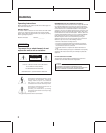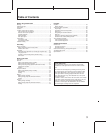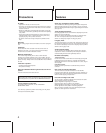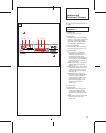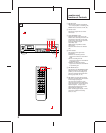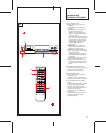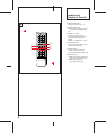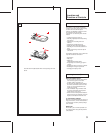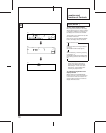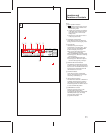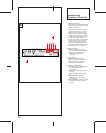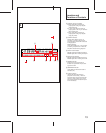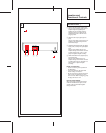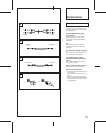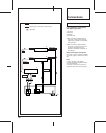
4
Precautions
On safety
• Operate the unit only on 120 V AC, 60 Hz.
• The unit is not disconnected from the AC power source (mains)
as long as it is connected to the wall outlet, even if the unit itself
has been turned off.
• Should any solid object or liquid fall into the cabinet, unplug the
unit and have it checked by qualified personnel before operating
it any further.
• Unplug the unit from the wall outlet if it is not to be used for an
extended period of time. To disconnect the cord, pull it out by
grasping the plug. Never pull the cord itself.
• AC power cord must be changed only at the qualified service
shop.
Operation
Before making program source connections, be sure to unplug the
unit.
Installation
Do not install the unit in a location near heat sources such as
radiators or air ducts, or in a place subject to direct sunlight,
excessive dust, mechanical vibration or shock.
Moisture Condensation
If the unit is brought directly from a cold to a warm location,
moisture may condense inside the unit. In this condition, the tape
may adhere to the head drum and be damaged, or the unit may not
operate correctly. Always remove the cassette when the unit will not
be used.
If moisture is present...
• Function controls will not operate.
• All operations will stop.
When the CAUTION indicator lights and the unit will not
operate
Leave the unit turned on for about an hour.
NOTE
When closing the cassette compartment, do not push the cassette
lid forcibly by hand, but perform with the 0OPEN/CLOSE button.
For the customers in the U.S.A.
For detailed safety precautions, see the “IMPORTANT
SAFEGUARDS” leaflet.
If you have any question or problem concerning your unit, please
consult your nearest Sony dealer.
Serial copy management system (SCMS)
This unit utilizes the serial copy management system that permits
digital-to-digital recording for one generation. You can record CD
sound or other digital formats through a digital-to-digital connection.
(See page 54.)
Three sampling frequencies
Recording/playback can be done with three sampling frequencies
(48 kHz, 44.1 kHz and 32 kHz).
48 kHz: For analog and digital input signals in a standard mode.
44.1 kHz: For compact disc and pre-recorded DAT tape.
32 kHz: For analog input signals in a long-play mode.
Long play mode
This unit can operate in a long-play mode. Analog input signals can
be recorded or playback for up to four consecutive hours when the
DT-120 DAT cassette tape is used. The sampling frequency will be
32 kHz in the long-play mode.
Visible cassette loading
You can view the tape operation through the lid of the cassette
compartment. Due to a revolutionary new transport mechanism,
cassette loading time has been significantly reduced.
Excellent sound quality
1-bit A/D converter
For the A/D converter section which converts analog input signals
to digital signals, the unit employs a 1-bit A/D converter which
theoretically generates no zero-cross distortion for a clear, elegant
sound quality.
Pulse D/A converter
Superior playback performance is achieved with a pulse D/A
converter.
Rich variety of subcode information
This unit can record subcode information such as Start IDs,
program numbers, Skip IDs, and absolute time data, enabling you
to quickly locate tunes and display the playback time in the same
manner as when playing compact discs.
Post edit recording of sub codes
You can record or rewrite the following sub codes after the audio
signal recording has been completed.
Start ID: Signifies the beginning of a selection.
Program number: Gives a number to the selection.
Skip ID: Signifies the beginning of a portion to be skipped.
End ID: Signifies the end position of recording/playback.
Since sub codes are written on the tape separately from audio
signals, the audio signals are not affected.
Features




